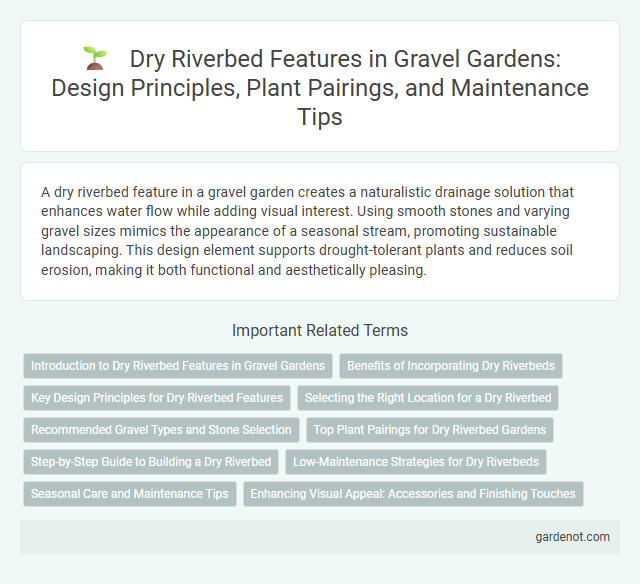A dry riverbed feature in a gravel garden creates a naturalistic drainage solution that enhances water flow while adding visual interest. Using smooth stones and varying gravel sizes mimics the appearance of a seasonal stream, promoting sustainable landscaping. This design element supports drought-tolerant plants and reduces soil erosion, making it both functional and aesthetically pleasing.
Introduction to Dry Riverbed Features in Gravel Gardens
Dry riverbed features in gravel gardens create naturalistic drainage channels composed of smooth stones and pebbles that mimic flowing water. These designs enhance landscape aesthetics while improving water runoff and preventing soil erosion. Incorporating native rocks and drought-tolerant plants around the dry riverbed supports sustainable gardening practices in arid environments.
Benefits of Incorporating Dry Riverbeds
Dry riverbeds enhance gravel gardens by improving drainage and preventing soil erosion, directing water flow efficiently during heavy rains. They create a visually appealing, naturalistic landscape element that reduces maintenance by minimizing muddy patches and standing water. Incorporating native stones and gravel in dry riverbeds supports local biodiversity and promotes sustainable gardening practices.
Key Design Principles for Dry Riverbed Features
A dry riverbed feature in a gravel garden enhances natural aesthetics by mimicking the flow and texture of real waterways through careful selection of rocks, gravel, and plants that thrive in arid conditions. Key design principles include creating a gradual slope for visual depth, using varied stone sizes to replicate natural sediment layers, and incorporating drought-tolerant species such as sedum, lavender, and ornamental grasses to maintain an authentic, low-maintenance landscape. Proper drainage planning ensures water does not pool, preserving the dry riverbed's distinct appearance and preventing erosion.
Selecting the Right Location for a Dry Riverbed
Choosing the right location for a dry riverbed in a gravel garden involves assessing soil drainage, sunlight exposure, and nearby plantings to ensure optimal water flow and aesthetic integration. Ideal sites often have a natural slope to facilitate water movement and avoid waterlogging, supporting drought-tolerant plants native to arid environments. Positioning the dry riverbed near walkways or focal points enhances garden design while promoting sustainable water management.
Recommended Gravel Types and Stone Selection
For a dry riverbed feature in a gravel garden, selecting angular gravel types like crushed granite or basalt ensures stability and mimics natural water flow patterns. Incorporating a mix of sizes, from fine gravel to larger cobbles and smooth river stones, enhances visual texture while promoting proper drainage. Opt for stones with natural hues such as gray, tan, and rust to blend seamlessly with the surrounding landscape.
Top Plant Pairings for Dry Riverbed Gardens
Top plant pairings for dry riverbed gardens include drought-tolerant species such as ornamental grasses, succulents, and native wildflowers that thrive in well-drained gravel soils. Combining resilient plants like lavender, sedum, and yarrow enhances texture and color contrast while requiring minimal water. Incorporating deep-rooted plants like ornamental grasses alongside low-growing groundcovers creates a natural, flowing aesthetic that mimics a true dry riverbed environment.
Step-by-Step Guide to Building a Dry Riverbed
Creating a dry riverbed involves selecting a natural, meandering path through your gravel garden, then excavating a shallow trench that mimics the flow of water. Line the trench with landscaping fabric to prevent weed growth, layer various sizes of smooth river rocks and gravel for texture, and strategically place larger boulders to simulate rapids and pools. Incorporate native drought-tolerant plants along the edges to enhance the aesthetic and promote local biodiversity.
Low-Maintenance Strategies for Dry Riverbeds
Incorporating low-maintenance strategies for dry riverbeds in gravel gardens involves selecting drought-tolerant plants such as ornamental grasses and succulents that require minimal watering. Utilizing permeable gravel and larger stones allows efficient water drainage and reduces erosion, keeping the feature intact with little upkeep. Mulching with organic materials helps retain soil moisture, suppresses weeds, and enhances nutrient retention, contributing to sustainable low-maintenance management of dry riverbeds.
Seasonal Care and Maintenance Tips
Dry riverbed features require regular seasonal care to prevent debris buildup and erosion, ensuring optimal drainage in gravel gardens. During spring and fall, remove leaves, twigs, and sediment to maintain water flow and prevent clogging. Inspect rocks and gravel placement after heavy rain, adjusting as needed to preserve the riverbed's natural appearance and function.
Enhancing Visual Appeal: Accessories and Finishing Touches
Incorporating natural stones, textured pebbles, and weathered driftwood accents enhances the visual appeal of a dry riverbed in a gravel garden by creating a dynamic, organic look. Carefully placed ornamental grasses and drought-tolerant succulents introduce subtle color contrasts and soft edges, complementing the hardscape elements. Decorative boulders and sculptural metalwork serve as focal points, adding depth and artistic interest to the landscape design.
Dry riverbed feature Infographic

 gardenot.com
gardenot.com